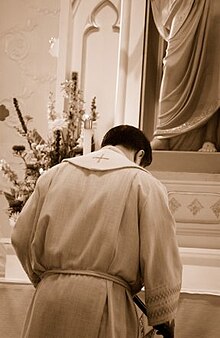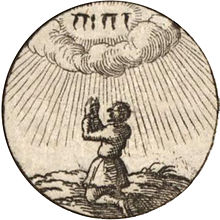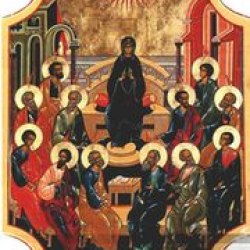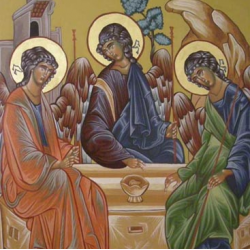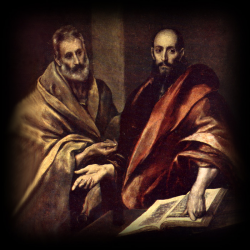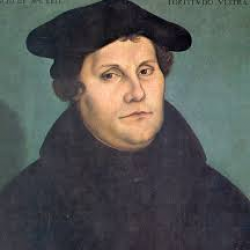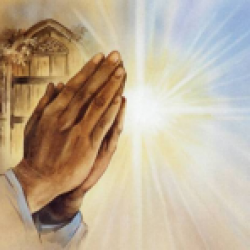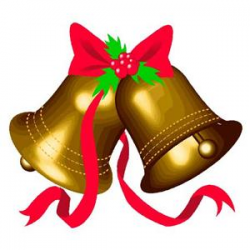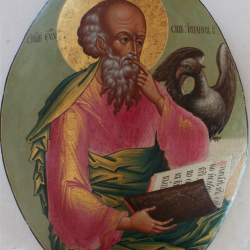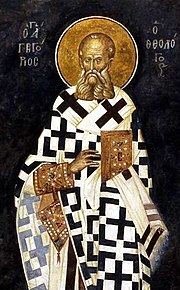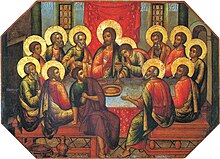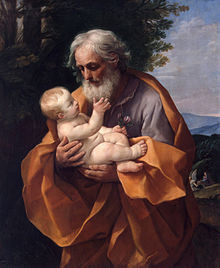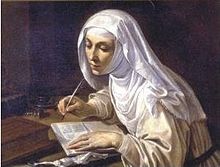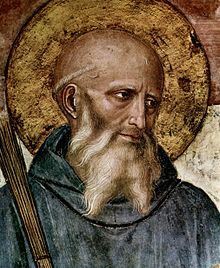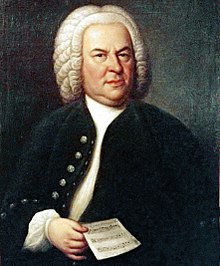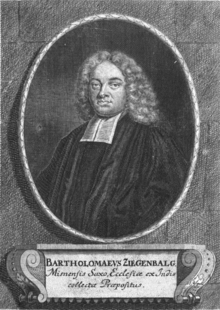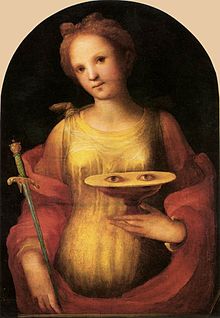
Я лютеран люблю богослуженье,
Обряд их строгий, важный и простой —
Сих голых стен, сей храмины пустой
Понятно мне высокое ученье.
Не видите ль? Собравшися в дорогу,
В последний раз вам вера предстоит:
Еще она не перешла порогу,
Но дом ее уж пуст и гол стоит, —
Еще она не перешла порогу,
Еще за ней не затворилась дверь…
Но час настал, пробил… Молитесь богу,
В последний раз вы молитесь теперь.
Ф.И. Тютчев
Лютеранство — одно из первых по времени течений, возникших в протестантизме. Сейчас лютеранство является третьей по численности христианской деноминацией в мире и насчитывается 66,2 миллионов верующих.
Наибольшее лютеранское население, по данным на начало 21 века, было в Германии (14,7 млн.), США, Канаде (8,7 млн.) и Швеции (7,6 млн.), однако немало лютеран и в Африке (6 млн.) и в Индонезии (2,4 млн.). В России и других странах СНГ — примерно 265 тысяч лютеран.
Так откуда же произошло лютеранство? Возникновение лютеранства связано с Реформацией в Европе в 16 веке. Реформаторы, одним из которых был Мартин Лютер, вели борьбу за очищение Римско-католической церкви от существовавших недостатков, ее обновление в духе Библии и первых веков христианства. Эта борьба и привела к появлению первых протестантских церквей — лютеранской и реформатской. Уже в 16 веке первые лютеране попали в Россию.
Сейчас по всему миру много Лютеранских Церквей — все они, несмотря на некоторые богословские разночтения, входят во Всемирную Лютеранскую Федерацию (ВЛФ). Личность самого основателя Мартина Лютера не превозносится, он не является святым или пророком, но его герб (так называемая «Роза Лютера») исторически стал символом лютеранства и нередко изображается на книгах или скромно присутствует в храмах.
В отличие от многих других протестантских Церквей, в Лютеранской Церкви осталось много связанного с католичеством. Многие вопросы, поднятые протестантизмом (об иконопочитании, посте, исповеди, почитании святых) были решены здесь не столь однозначно, как в других разновидностях протестантизма.
С одной стороны, взяв, как и другие протестанты, за основу вероучения Библию, лютеране исключили из своей практики праздники богородичного цикла, дни памяти многих святых. С другой стороны, в Лютеранской Церкви осталось значительно больше праздников, чем у других протестантских Церквей, многие храмы носят имена святых, а их стены украшены не иконами, но алтарными картинами.
Замечательно то, что лютеранское богослужение почти с самого своего появления было очень музыкально — лютеране ввели в свое богослужение орган (кто не слышал музыку лютеранина Иоганна Баха!), а затем и ряд других музыкальных инструментов, сочетая при этом песнопения на латыни и на других языках.
Это смешение старых и новых элементов оказалось очень гармоничным и придает оригинальность и невыразимую прелесть этой религиозной традиции. Вот как описывает свое восприятие и впечатление от лютеранских богослужений Осип Мандельштам:
Здесь прихожане — дети праха
И доски вместо образов,
Где мелом Себастьяна Баха
Лишь цифры значатся псалмов.
Разноголосица какая
В трактирах буйных и в церквах —
А ты ликуешь, как Исайя,
О, рассудительнейший Бах!
Высокий спорщик, неужели,
Играя внукам свой хорал,
Опору духа в самом деле
Ты в доказательстве искал?
Что звук? Шестнадцатые доли,
Органа многосложный крик
Лишь воркотня твоя — не боле,
О, несговорчивый старик!
И лютеранский проповедник
На черной кафедре своей
С твоими, гневный собеседник,
Мешает звук своих речей…
Все лютеранские праздники можно разделить на несколько групп:
— праздники, связанные с Иисусом Христом (Рождество, Крещение, Пасха);
— праздники, связанные с евангелистами (Матфей, Марк, Лука, Иоанн);
— праздники, связанные с апостолами, святыми, мучениками, пророками (Петр и Павел, Иоанн Креститель);
— праздники, связанные с памятными днями церковной истории (День Реформации и др.);
— праздники, связанные с народными традициями (Жатва).
Полный годичный круг лютеранских праздников можно разделить на два больших периода: рождественский и пасхальный. Началом рождественского периода, как и началом церковного года, является Адвент. Адвент (с лат. «пришествие») — период ожидания и подготовки к Рождеству Христову, который начинается в ближайшее календарное воскресенье к 30 ноября и длится около 4 недель.
Глубинный смысл Адвента заключается в ожидании тройственного пришествия: 1) пришествия «в полноте времен» (воплощение бога в Сыне, Иисусе Христе); 2) пришествия в Слове и таинстве (земное служение и новый Завет Спасителя); 3) пришествия в конце времен (второе пришествие Христа). Адвент — время покаянных размышлений над своей жизнью и ожидания праздника божественного искупления, то есть ожидания не только Рождества, но и Пасхи.
Рождественская часть праздников подготавливается Адвентом, достигает вершины в праздники Рождества и Богоявления. Пасхальная часть года начинается с праздников, связанных с Великим постом, достигает кульминации в дни Пасхи (Страстную неделю) и продолжается воскресениями после Пятидесятницы. Кстати, в лютеранстве, в отличие от Римско-католической и Православной Церквей, праздники Пятидесятницы и Троицы приходятся не на один день, а следуют друг за другом с недельным разрывом.
Единственный праздник, который «выбивается» из пасхального круга, но в тоже время и роднит Лютеранскую Церковь с другими протестантскими Церквями — это Жатва (день благодарения за урожай).
В России несколько этнических традиций лютеранства (немецкая, финская, эстонская, шведская, русская), каждый праздник может варьироваться в зависимости от национальных особенностей празднующих его лютеран. Нередко, когда отмечают какой-то крупный праздник, его празднование продолжается концертом классической музыки (особенно любимы произведения И.С. Баха, В.А. Моцарта и других немецких композиторов) или театрализованным представлением.
The Lutheran liturgical calendar is a listing which details the primary annual festivals and events that are celebrated liturgically by various Lutheran churches. The calendars of the Evangelical Lutheran Church in America (ELCA) and the Evangelical Lutheran Church in Canada (ELCIC) are from the 1978 Lutheran Book of Worship and the calendar of the Lutheran Church–Missouri Synod (LCMS) and the Lutheran Church–Canada (LCC) use the Lutheran Book of Worship and the 1982 Lutheran Worship. Elements unique to the ELCA have been updated from the Lutheran Book of Worship to reflect changes resulting from the publication of Evangelical Lutheran Worship in 2006. The elements of the calendar unique to the LCMS have also been updated from Lutheran Worship and the Lutheran Book of Worship to reflect the 2006 publication of the Lutheran Service Book.
The basic element to the calendar is Sunday, which is a festival of Jesus’ resurrection. However, Christian denominations have historically observed other festivals which commemorate events in the life of Jesus or of significant individuals in the history of the Church.[1]
Structure[edit]
Lutheran church year and the temperate seasons of the Earth’s Northern Hemisphere.
The Lutheran calendar operates on two different cycles: the Temporal Cycle and the Sanctoral Cycle. The Temporal Cycle pivots on the festivals of Christmas and Easter. All Sundays, Seasons, and Festivals are related to these festivals.[2] Because Easter varies in date each year based on the vernal equinox and the phases of the moon, it is called a moveable feast (see: Computus). Dates affected by placement of Easter include Ash Wednesday and the start of Lent, the start of Easter itself, Pentecost, and Holy Trinity.[3] Advent, the other pivotal season on the calendar, comes exactly four Sundays before the start of Christmas (if Christmas falls on a Sunday, that day does not count), or the Sunday closest to St. Andrew’s Day (November 30).[3] Like the other Western Church calendars, the first Sunday of Advent is also the first day of the liturgical year.[4] The Sanctoral Cycle is the fixed daily commemorations of individuals and events not related to the Temporal Cycle of Sundays, Festivals, and Seasons.[5]
Festivals[edit]
The Festivals are Nativity, Epiphany, the Baptism of our Lord, the Transfiguration, the Annunciation, Palm Sunday, Easter, the Ascension, Pentecost, Holy Trinity, All Saints, and Christ the King.[6] Most of these festivals are tied to the moveable feast of Easter. Festivals take precedence over all other days, including Sundays, have their own collects and Eucharistic proper prefaces. Of the festivals, Christmas is considered to be twelve days in length (from December 25 until January 5) and Easter is fifty days in length (from Easter Sunday up to and inclusive of Pentecost).[7] For Easter, Sundays are considered to be another part of the festival. For the Ascension which, falling on fortieth day of Easter, will always be on a Thursday, the festival is sometimes transferred to the Seventh Sunday of Easter in addition to or in place of the normal part of the Easter festival for that day.[8]
There is another type of day which, while not a festival, is considered to be equal with a festival. These days, called Days of Special Devotion, are Ash Wednesday and all the days of Holy Week, especially Good Friday.[9] These particular days, like other festivals, automatically take precedence over any event on the calendar and sometimes even over other festivals. A good example of this would be in 2005 when Good Friday and the Annunciation fell on the same day (March 25). The Annunciation was transferred to March 28, or the second day of Easter, to make room for Good Friday.[10] The principle of the Church of Sweden is that the Annunciation is celebrated on the Sunday between 21–27 March; although, should Good Friday or any other day of Holy Week, or Easter Sunday or Monday respectively, fall on 25 March, Annunciation is moved to the Sunday before Palm Sunday. (For instance, in 2003 Annunciation was celebrated on 13 March; 2008 (when Easter Sunday was 23 March) it was celebrated on 9 March.)
One unique feature of the ELCA calendar is that it has given congregations the options of two dates for the Transfiguration.[9]
Lesser Festivals[edit]
These are days which are associated with the life of Christ or the Apostles and deserve attention in their own right. Lesser Festivals do not have priority over festivals and technically do not have precedence over ordinary Sundays. However, the Lutheran Book of Worship does permit the celebration of a Lesser Festival on Sundays where the normal color of the day would be green (that is, seasons after Epiphany or after Pentecost) or on the Sundays in Christmas.[11] This is abrogated for patronal festivals (that is, the day commemorating the saint or event for which a congregation is named) provided that they do not take place in Lent, Advent, or Easter, in which case they must also be transferred to the next convenient weekday.[11]
Commemorations[edit]
Commemorations are for individuals or events which have been noteworthy in the life of the Church and in the history of Lutheranism in particular.[12] These days do not take precedence over any other festival day, and if there is a conflict between a commemoration and a festival of any other rank, the commemoration is generally transferred to the next open weekday. If a commemoration falls on a Sunday where the color of the day is green, the collect for which that individual or event belong to could be said before the daily collect/prayer of the day or in place of it. For example, if September 13 fell on a Sunday and there was a desire to commemorate St. John Chrysostom, the pastor would recite the common of theologians and then the prayer of the day or the common of theologians on its own. The person may also be mentioned by name in the prayers of the faithful in addition to recitation of the applicable collect. Finally, their lives might be summarized or their teachings related to the day’s lessons in some way.[13]
In cases of conflict between commemorations (for example, November 11 with St. Martin of Tours and Søren Kierkegaard), there is no order of precedence, and individual worship planners need to choose which commemoration, if any, to highlight. In some cases, several individuals are listed together (June 14 with St. Basil the Great, St. Gregory the Theologian, and St. Gregory of Nyssa) because of their close association with each other, and they are thus designed to be commemorated jointly, not as a choice between one or the other.[14]
The schedule of commemorations within the ELCA has been specifically designed so that there is at least one person on the calendar from each century so as to emphasize the continuity of Christian tradition.[15] Clearly, some centuries have more commemorations than others, the largest number of persons commemorated being in the first four centuries of Christian history and immediately following the Reformation. This leaves the space from the 5th to the 15th centuries and the 16th to the 20th centuries rather sparse; nevertheless, it is an improvement over some calendars wherein only a very few persons, all from the patristic or Reformation periods, were commemorated.[16]
Liturgical colors[edit]
A Lutheran pastor celebrating the Eucharist during the Easter season
The service books of Lutheran Churches designate specific colors for events which are listed on the liturgical calendars and the seasons which are a part of the Temporal Cycle. This color is sometimes known as “the color of the day.” The Lutheran Church generally follows the color scheme which is used by other churches in Western Christianity since Lutheranism has historically been linked with the Roman Catholic Church. The color of the day dictates the color of the vestments for all ministers and the color of paraments. White is the color designated for Festivals of Christ, with gold sometimes offered as an alternative for the first days of Easter.[17]
White is also used as the color for anyone commemorated on the calendar who was not martyred and is the color appointed for funerals regardless of whatever the color of the day might otherwise be. Purple is commonly used for the season of Lent. It is also optional for use during Advent, though blue is the preferred color for this season because of its hopeful connotations rather than the penitential character implied by purple and its association with Lent.[17]
Historical development[edit]
Liturgical calendars began to be developed in Christianity around the fourth century, with the church calendar as it is known today coming into full development in the period of the medieval sacramentaries.[18] While Sunday had long been established in the weekly calendar, festivals such as Easter and Christmas were also a fixed part of the calendar by this time. The ninth century also saw the inclusion of numerous saints in the calendar (a practice already begun by the second century), even to the point that normal Sunday propers were taking place over those normally appointed for Sunday.[19]
Reformation era[edit]
All of the Reformers attempted to reduce the number of individual commemorations and “saint’s days”, though this reduction was sometimes more drastic than others. In the case of the Lutheran churches, most of the saints’ days were removed (with the exception of some New Testament personages), though the basic temporal cycle of the calendar remained more or less intact.[20] In some instances, a celebration of the Reformation was added to October 31, the first instance being the church order prepared by Johannes Bugenhagen, though other churches selected alternative dates, including June 25, the anniversary of the presentation of the Augsburg Confession.[21] The commemoration of the Reformation quickly died out before the Thirty Years War.[12]
In Germany[edit]
The content of the liturgical calendar (like the content of the liturgy itself) was the responsibility of territory in which the church was found.[22] Thus, there was a different order for Saxony, one for Prussia, one for Hesse, and one for Wittenberg, among others. Despite their differences, the calendars and liturgies maintained significant similarities between each other as well as the calendar of the Roman Catholic Church. The church year continued to begin with the First Sunday of Advent (which was still fixed based on the traditional formula), and many of the festivals surrounding Christmas (St. Stephen, St. John, the Holy Innocents) remained in place, even if they were often ignored.[22] Epiphany also continued to be celebrated as the visit of the Magi, though Martin Luther preferred to commemorate the baptism of Christ.[23]
Brandenburg and Calenburg and Göttingen retained Lent and the fasting days associated with the season. They also retained the violet or black vestments for the penitential season.[23] However, popular devotions such as the blessing of palms or the imposition of ashes were suppressed in most church orders,[24] despite the fact that a number of them had retained Ash Wednesday as the start of Lent. Good Friday, while kept with solemnity, was often a celebration of Holy Communion, thus less somber than the contemporary Roman Catholic Church.[23] And while Easter had been a common day of communion in the church before the reformation, “the reformers tried to prevent too many communions on this day, and instead urged the faithful to receive it on various Sundays throughout the year.”[23] The Reformation also saw the development of a new “festival” connected to Easter, where the second Sunday became popularly known as “Good Shepherd Sunday” based on the opening of the psalm appointed for the day, Misericordia domini or “Goodness of the Lord”.[23] In addition, Corpus Christi was commonly retained until about 1600, owing to its significant popularity in the Medieval period.[21]
While many saints were removed from liturgical calendars by the reformers, some were nevertheless retained. St. Ansgar was commemorated in Halberstadt and Nordligen with a special thanksgiving service on the Sunday after 3 February, no doubt because of the saint’s historic connection to the area.[25] The same was true of Elizabeth of Thuringia in the Schweinfurth Order, and St. George was also commemorated in Nordlingen.[25] Festivals of the apostles and evangelists were also found on Lutheran calendars of the era, but were not always observed if they fell on a day other than Sunday.[25] Some of the Marian festivals, notably the Nativity of Mary (September 
In Scandinavian countries[edit]
Martin Luther, commemorated on February 18[26]
When the Lutheran Reformation was brought to Sweden from Germany via Denmark after the election of Gustav Vasa in 1523, the movement from the start had its own distinct characteristics. The development of Swedish liturgy was, in part, thanks to Olavus Petri, which is sometimes regarded as his most important work.[27] His Swedish Mass, 1531 remained in use, with only slight modifications, until the twentieth century.[27] The Swedish Mass draws from a number of different sources, though Luther’s Formulae Missae is apparent in regards to the Eucharistic structure.[28]
Changes included revising the calendar along similar lines as those in Germany. Laurentius Petri further revised the Swedish Mass 1557. In large part, the Swedish liturgy retained “vestments, altars and frontals, gold and silver chalices and patens” and many other “popish” customs.[29] Following Laurentius’ death in 1573, King John III embarked on a separate, though similar, religious policy more conciliatory towards Catholicism. Much of his work was in the area of liturgy and his Nova Ordinantia reinstated much of the sanctoral cycle from the Old Swedish Mass, reviving the feasts of St. Mary Magdalene, St. Lawrence, Corpus Christi, and the Assumption and Nativity of the Virgin Mary.[30]
Modern era[edit]
The majority of calendars between the start of the Reformation and the 20th century were quite minimal in their commemorations. Most included events such as the Annunciation or persons such as Saint Paul, these days often went unobserved despite scrupulous attention to the temporal cycle. Even further, the commemoration of some biblical persons of note (including the Virgin Mary) were often omitted entirely.[31]
Calendar in Europe[edit]
Many of the changes to the calendar that had accompanied the Reformation remained in place during the subsequent centuries. In Saxony in the eighteenth century, in addition to chief festivals of Christmas, Easter, and Pentecost, a number of festivals were also celebrated with Vespers and Holy Communion, including Saint Stephen, Saint John, the Circumcision, Epiphany, Purification of Mary, the Annunciation, the Ascension, Holy Trinity, Nativity of Saint John the Baptist, the Visitation (on July 2), and Saint Michael (on September 29).[32] When Holy Communion was celebrated, a chasuble was used in the color of the day, though especially at Leipzig, these colors were different from the ones normally used today.[33] In the twentieth century, Lutherans in Europe came under the influence of the Liturgical Movement and many Lutheran churches adopted new calendars and rubrics similar to the Roman Calendar as revised by Vatican II.[34]
The calendar in North America[edit]
When Lutherans came to North America, they brought with them their disparate liturgical traditions. The Pennsylvania Ministerium composed the first liturgy for North America, including its calendar along somewhat minimal lines. However, since the last quarter of the nineteenth century, the calendar within North American Lutheran churches has been expanding.[35] In 1868, four chief festivals in the Church Book were Christmas, New Year’s Day, Epiphany, and Reformation Day, with Easter and Pentecost being considered a separate category because they invariably fell on Sunday.[35] The Church Book also included several minor festivals, including festivals for all the Apostles, and the Annunciation. The Common Service Book (1918) also expanded the calendar to help congregations determine which days took priority over others in cases of coincidence. It added to the calendar the Sundays of Advent, Transfiguration (last Sunday after Epiphany), Septuagesima, Sexagesima, Quinquagesima, Ash Wednesday, Sundays in Lent, all days in Holy Week, Ascension and the following Sunday, and Holy Trinity. It also included All Saints, and Saints Mark and Luke, both of which were omitted from the Church Book.[36] The Service Book and Hymnal (1941) also moved the Transfiguration to August 6 and added Holy Innocents to the calendar.[37]
The previous North American calendar of the ELCA was different from its European counterparts in that it does not give equal weight (and sometimes gives no mention) to persons who may be commemorated in Scandinavian regions. One example would be the absence of St. Lucia on December 13, although she enjoys particular popularity in Sweden.[5] But Lutheran calendars also differ amongst one another in North America, with some individuals commemorated on multiple calendars but on different days (e.g., St. Bernard of Clairvaux on August 19 in the LCMS and August 20 in the ELCA) or individuals commemorated on one calendar and not the other (e.g., Martin Luther King Jr. on January 15 (his birthday) for the ELCA and C. F. W. Walther on May 7 for the LCMS); with the 2006 publication of Evangelical Lutheran Worship (ELW) as a replacement to the Lutheran Book of Worship (LBW), some of these deficiencies in the ELCA calendar have been corrected. Within the ELCA, This Far by Faith and Libro de Liturgia y Cantico both prescribe calendars with additional commemorations specific to the ethnic communities they were intended to be used in (African Americans and Latinos respectively).[38] The Wisconsin Evangelical Lutheran Synod has a different, somewhat minimized calendar when compared the LCMS and especially the ELCA.[39]
Differences from other calendars[edit]
First, the Lutheran calendar, while commemorating many of the same events or persons, often does so on different days from either calendar (St. Cyprian of Carthage on September 16 for Lutherans, but September 13 in the Episcopal Church[40]). In other cases (such as St. Valentine on February 14), individuals who have long standing within Western Christianity are not mentioned in the Lutheran calendar, or are only mentioned in the calendars of some Lutheran churches.[41] Furthermore, some Lutheran calendars (such as that of the LCMS) still venerate individuals whose commemorations have been suppressed in other Western Churches. Finally, the Lutheran calendar commemorates persons or events (such as the presentation of the Augsburg Confession on June 25) which are not commemorated in any other Christian calendar because of their specific importance to the Lutheran Church.[12]
The other significant difference is that the Lutheran calendar commemorates a wider variety of individuals than does either of its counterparts. Included on the calendar are musicians and artists who are associated with the Church, but are not typically thought of as “saints” in the classical sense. The intent is to provide a wider venue for commemoration of outstanding individuals who have served the Church through their vocations rather than simply commemorating the outstanding among the religious.[42]
The calendar for the ELCA is similar to many other Western Calendars in that it does not commemorate any persons from the Old Testament.[15] The calendars of the Orthodox Churches have Old Testament individuals, and the Lutheran Church–Missouri Synod has done the same. At one point there was a proposal to include a day on the Episcopal Church calendar (which was taken into consideration by the Inter-Lutheran Commission on Worship in developing the Lutheran Book of Worship) for Old Testament saints following the octave of All Saints (November 8), but this idea was ultimately rejected as tokenism.[15]
«Saints» in the liturgical calendar[edit]
Illustration from the Augsburg Confession.»Scripture does not teach calling on the saints or pleading for help from them. For it sets before us Christ alone as mediator, atoning sacrifice, high priest, and intercessor.»— Augsburg Confession, Article XXI.[43]
There is also no use of the title «saint» for anyone other than biblical persons (and even then the title is used with a certain degree of exclusivity). This is to prevent oddities of convention (such as St. Nicolaus Copernicus)[44] as well as to underline the Lutheran emphasis on the priesthood of all believers. Nevertheless, individuals who typically have «saint» affixed to their given name are still referred to as such in common discourse (so that Francis of Assisi would still be called «St. Francis» rather than just «Francis»).[44]
In the New Testament, all Christians are referred to as saints. However, the use of «saint» as a title for an individual who had led a good and exemplary life or who had been martyred began to develop in Christianity. By the time of the Reformation, the use of «saint» was almost exclusively the restrictive, titular sense.[45] One of the effects of the Reformation was to eliminate the abuses of the cult of saints, and as a result, it is a common misconception that Lutherans do not have (or rather, do not venerate) saints. However, the confessional documents of the Lutheran Church, particularly the Augsburg Confession, accept both the general and particular use of the word saints.[46] In regards to the titular sense, the Augsburg Confession commends that «it should be taught among us that saints should be kept in remembrance so that our faith may be strengthened when we see what grace they received and how they were sustained in faith. Moreover, their good works are to be an example for us, each of us in his own calling.»[46] Article XXI of The Apology to the Augsburg Confession goes further to describe three types of honor which are due to the saints and acknowledgment that the saints pray for the Church.[45] However, the Augsburg Confession opposes prayer to saints, stating, «Scripture does not teach calling on the saints or pleading for help from them. For it sets before us Christ alone as mediator, atoning sacrifice, high priest, and intercessor.»[47]
See also[edit]
- Calendar of saints (Lutheran)
- For calendars besides the Lutheran calendar, see:
-
- Calendar of saints (Anglican)
- Calendar of saints (Roman Catholic)
- Calendar of saints (Eastern Orthodox).
Notes[edit]
- ^ «What Is a Lesser Festival and How Do We Celebrate Them». Evangelical Lutheran Church in America. Retrieved 4 November 2009.
- ^ Phillip Pfatteicher, Festivals and Commemorations, p. 11.
- ^ a b Phillip Pfatteicher, Lutheran Book of Worship: Manual on the Liturgy, p. 22.
- ^ Pfatteicher, Lutheran Book of Worship: Manual on the Liturgy, p. 22.
- ^ a b Pfatteicher, Festivals and Commemorations, p. 11.
- ^ Evangelical Lutheran Worship, p. 3 and Lutheran Service Book, p. xi
- ^ Phillip Pfatteicher, Commentary on the Lutheran Book of Worship, p. 498.
- ^ Evangelical Lutheran Worship, p. 23.
- ^ a b Pfatteicher, Commentary on the Lutheran Book of Worship, p. 498.
- ^ Philip Pfatteicher, Festivals and Commemorations, 132.
- ^ a b Pffatteicher, Lutheran Book of Worship: Minister’s Desk Edition, 21.
- ^ a b c Pfatteicher, Commentary on the Lutheran Book of Worship, p. 22.
- ^ «ELCA Frequently Asked Questions on Worship». Evangelical Lutheran Church in America. Retrieved 4 November 2009.
- ^ Pfatteicher, Festivals and Commemorations, p. 20
- ^ a b c Pfatteicher, Festivals and Commemorations, 19.
- ^ Phillip Pfatteicher, Commentary on the Lutheran Book of Worship, p. 22.
- ^ a b «The Meaning and Use of Liturgical Colors». Evangelical Lutheran Church in America. Archived from the original on 4 April 2012. Retrieved 5 November 2009.
- ^ Frank C. Senn, Christian Worship, p. 188.
- ^ Senn, Christian Worship, p. 162-163, 188.
- ^ Pfatteicher, Festivals and Commemorations, 11.
- ^ a b c Senn, Christian Worship, p. 344.
- ^ a b Senn, Christian Worship, p. 342.
- ^ a b c d e Senn, Christian Worship, p. 343.
- ^ Senn, Christian Worship, p. 346.
- ^ a b c Senn, Christian Worship, p. 345.
- ^ Evangelical Lutheran Worship. Minneapolis: Fortress Press (2006), 15.
- ^ a b Senn, Christian Worship, p. 404.
- ^ Senn, Christian Worship, p. 407.
- ^ Senn, Christian Worship, p. 415.
- ^ Senn, Christian Worship, p. 419.
- ^ Pfatteicher, Festivals and Commemorations, 11-12.
- ^ Senn, Christian Worship, p. 500.
- ^ Senn, Christian Worship, p. 500-501.
- ^ Senn, Christian Worship, p. 657-658.
- ^ a b Pfatteicher, Commentary on the Lutheran Book of Worship, p. 20.
- ^ Pfatteicher, Commentary on the Lutheran Book of Worship, p. 20-21.
- ^ Service Book and Hymnal, p. 278
- ^ ELCA Worship Resources Official Webpage Archived 2007-07-11 at the Wayback Machine
- ^ The majority of WELS congregations utilize The Service Book and Hymnal or Christian Worship: A Lutheran Hymnal, neither of which have extensive calendars of commemorations. The LCMS prayerbook, Lutheran Worship, is available through the official WELS publisher, Northwestern Publishing House, which would provide congregations utilizing that prayerbook a larger calendar to select from. Unlike the ELCA and the LCMS, the WELS does not maintain an official Sanctoral Cycle, but they do have congregational resources available for the full Temporal Cycle on their website.
- ^ cf. Calendar of Saints (Episcopal Church); of note, Cyprian is commemorated on September 16 in the Roman Catholic Calendar.
- ^ cf. Calendar of Saints (Lutheran) where Valentine is commemorated by the LCMS but is not commemorated by the ELCA.
- ^ Pfatteicher, Festivals and Commemorations, 18
- ^ Augsburg Confession, Article 21, «Of the Worship of the Saints». trans. Kolb, R., Wengert, T., and Arand, C. Minneapolis: Fortress Press, 2000.
- ^ a b Pfatteicher, Commentary on the Lutheran Book of Worship, 22.
- ^ a b Pfatteicher, Festivals and Commemorations, p. 12.
- ^ a b Robert Kolb and James Schaffer, The Book of Concord: The Confessions of the Evangelical Lutheran Church, Augsburg Confession, Article XXI.
- ^ Augsburg Confession Article XXI. Augsburg Confession, Article 21, «Of the Worship of the Saints». trans. Kolb, R., Wengert, T., and Arand, C. Minneapolis: Augsburg Fortress, 2000.
References[edit]
- Evangelical Lutheran Church in America. Evangelical Lutheran Worship — Final Draft. Minneapolis; Augsburg Fortress Press, 2006.
- ——. Evangelical Lutheran Worship . Minneapolis; Augsburg Fortress Press, 2006
- Inter-Lutheran Commission on Worship. Lutheran Book of Worship. Augsburg Fortress Press, 1978.
- Inter-Lutheran Commission on Worship. Lutheran Book of Worship: Minister’s Desk Edition. Minneapolis; Augsburg Fortress Press, 1978.
- Kolb, Robert and James Schaffer. The Book of Concord: The Confessions of the Evangelical Lutheran Church. Minneapolis: Augsburg Fortress Press, 2001.
- Lutheran Church–Missouri Synod. Lutheran Worship. Concordia Publishing House, 1982.
- Lutheran Church–Missouri Synod. Lutheran Service Book. Concordia Publishing House, 2006.
- Pfatteicher, Philip H. The Lutheran Book of Worship: Manual on the Liturgy. Minneapolis: Augsburg Fortress Press, 1979.
- ——.Festivals and Commemorations: Handbook to the Calendar in Lutheran Book of Worship. Minneapolis: Augsburg Fortress Press, 1980.
- ——. Commentary on the Lutheran Book of Worship. Minneapolis: Augsburg Fortress Press, 1990.
- Senn, Frank C. Christian Worship: Catholic and Evangelical. Minneapolis: Augsburg Fortress Press, 1997
Further reading[edit]
- «Commemorations — Church Year». The Lutheran Church–Missouri Synod. Archived from the original on 2020-04-14. Retrieved 2020-04-14.
- «Feasts and Festivals — Church Year». The Lutheran Church–Missouri Synod. Archived from the original on 2020-04-14. Retrieved 2020-04-14.
The Lutheran liturgical calendar is a listing which details the primary annual festivals and events that are celebrated liturgically by various Lutheran churches. The calendars of the Evangelical Lutheran Church in America (ELCA) and the Evangelical Lutheran Church in Canada (ELCIC) are from the 1978 Lutheran Book of Worship and the calendar of the Lutheran Church–Missouri Synod (LCMS) and the Lutheran Church–Canada (LCC) use the Lutheran Book of Worship and the 1982 Lutheran Worship. Elements unique to the ELCA have been updated from the Lutheran Book of Worship to reflect changes resulting from the publication of Evangelical Lutheran Worship in 2006. The elements of the calendar unique to the LCMS have also been updated from Lutheran Worship and the Lutheran Book of Worship to reflect the 2006 publication of the Lutheran Service Book.
The basic element to the calendar is Sunday, which is a festival of Jesus’ resurrection. However, Christian denominations have historically observed other festivals which commemorate events in the life of Jesus or of significant individuals in the history of the Church.[1]
Structure[edit]
Lutheran church year and the temperate seasons of the Earth’s Northern Hemisphere.
The Lutheran calendar operates on two different cycles: the Temporal Cycle and the Sanctoral Cycle. The Temporal Cycle pivots on the festivals of Christmas and Easter. All Sundays, Seasons, and Festivals are related to these festivals.[2] Because Easter varies in date each year based on the vernal equinox and the phases of the moon, it is called a moveable feast (see: Computus). Dates affected by placement of Easter include Ash Wednesday and the start of Lent, the start of Easter itself, Pentecost, and Holy Trinity.[3] Advent, the other pivotal season on the calendar, comes exactly four Sundays before the start of Christmas (if Christmas falls on a Sunday, that day does not count), or the Sunday closest to St. Andrew’s Day (November 30).[3] Like the other Western Church calendars, the first Sunday of Advent is also the first day of the liturgical year.[4] The Sanctoral Cycle is the fixed daily commemorations of individuals and events not related to the Temporal Cycle of Sundays, Festivals, and Seasons.[5]
Festivals[edit]
The Festivals are Nativity, Epiphany, the Baptism of our Lord, the Transfiguration, the Annunciation, Palm Sunday, Easter, the Ascension, Pentecost, Holy Trinity, All Saints, and Christ the King.[6] Most of these festivals are tied to the moveable feast of Easter. Festivals take precedence over all other days, including Sundays, have their own collects and Eucharistic proper prefaces. Of the festivals, Christmas is considered to be twelve days in length (from December 25 until January 5) and Easter is fifty days in length (from Easter Sunday up to and inclusive of Pentecost).[7] For Easter, Sundays are considered to be another part of the festival. For the Ascension which, falling on fortieth day of Easter, will always be on a Thursday, the festival is sometimes transferred to the Seventh Sunday of Easter in addition to or in place of the normal part of the Easter festival for that day.[8]
There is another type of day which, while not a festival, is considered to be equal with a festival. These days, called Days of Special Devotion, are Ash Wednesday and all the days of Holy Week, especially Good Friday.[9] These particular days, like other festivals, automatically take precedence over any event on the calendar and sometimes even over other festivals. A good example of this would be in 2005 when Good Friday and the Annunciation fell on the same day (March 25). The Annunciation was transferred to March 28, or the second day of Easter, to make room for Good Friday.[10] The principle of the Church of Sweden is that the Annunciation is celebrated on the Sunday between 21–27 March; although, should Good Friday or any other day of Holy Week, or Easter Sunday or Monday respectively, fall on 25 March, Annunciation is moved to the Sunday before Palm Sunday. (For instance, in 2003 Annunciation was celebrated on 13 March; 2008 (when Easter Sunday was 23 March) it was celebrated on 9 March.)
One unique feature of the ELCA calendar is that it has given congregations the options of two dates for the Transfiguration.[9]
Lesser Festivals[edit]
These are days which are associated with the life of Christ or the Apostles and deserve attention in their own right. Lesser Festivals do not have priority over festivals and technically do not have precedence over ordinary Sundays. However, the Lutheran Book of Worship does permit the celebration of a Lesser Festival on Sundays where the normal color of the day would be green (that is, seasons after Epiphany or after Pentecost) or on the Sundays in Christmas.[11] This is abrogated for patronal festivals (that is, the day commemorating the saint or event for which a congregation is named) provided that they do not take place in Lent, Advent, or Easter, in which case they must also be transferred to the next convenient weekday.[11]
Commemorations[edit]
Commemorations are for individuals or events which have been noteworthy in the life of the Church and in the history of Lutheranism in particular.[12] These days do not take precedence over any other festival day, and if there is a conflict between a commemoration and a festival of any other rank, the commemoration is generally transferred to the next open weekday. If a commemoration falls on a Sunday where the color of the day is green, the collect for which that individual or event belong to could be said before the daily collect/prayer of the day or in place of it. For example, if September 13 fell on a Sunday and there was a desire to commemorate St. John Chrysostom, the pastor would recite the common of theologians and then the prayer of the day or the common of theologians on its own. The person may also be mentioned by name in the prayers of the faithful in addition to recitation of the applicable collect. Finally, their lives might be summarized or their teachings related to the day’s lessons in some way.[13]
In cases of conflict between commemorations (for example, November 11 with St. Martin of Tours and Søren Kierkegaard), there is no order of precedence, and individual worship planners need to choose which commemoration, if any, to highlight. In some cases, several individuals are listed together (June 14 with St. Basil the Great, St. Gregory the Theologian, and St. Gregory of Nyssa) because of their close association with each other, and they are thus designed to be commemorated jointly, not as a choice between one or the other.[14]
The schedule of commemorations within the ELCA has been specifically designed so that there is at least one person on the calendar from each century so as to emphasize the continuity of Christian tradition.[15] Clearly, some centuries have more commemorations than others, the largest number of persons commemorated being in the first four centuries of Christian history and immediately following the Reformation. This leaves the space from the 5th to the 15th centuries and the 16th to the 20th centuries rather sparse; nevertheless, it is an improvement over some calendars wherein only a very few persons, all from the patristic or Reformation periods, were commemorated.[16]
Liturgical colors[edit]
A Lutheran pastor celebrating the Eucharist during the Easter season
The service books of Lutheran Churches designate specific colors for events which are listed on the liturgical calendars and the seasons which are a part of the Temporal Cycle. This color is sometimes known as “the color of the day.” The Lutheran Church generally follows the color scheme which is used by other churches in Western Christianity since Lutheranism has historically been linked with the Roman Catholic Church. The color of the day dictates the color of the vestments for all ministers and the color of paraments. White is the color designated for Festivals of Christ, with gold sometimes offered as an alternative for the first days of Easter.[17]
White is also used as the color for anyone commemorated on the calendar who was not martyred and is the color appointed for funerals regardless of whatever the color of the day might otherwise be. Purple is commonly used for the season of Lent. It is also optional for use during Advent, though blue is the preferred color for this season because of its hopeful connotations rather than the penitential character implied by purple and its association with Lent.[17]
Historical development[edit]
Liturgical calendars began to be developed in Christianity around the fourth century, with the church calendar as it is known today coming into full development in the period of the medieval sacramentaries.[18] While Sunday had long been established in the weekly calendar, festivals such as Easter and Christmas were also a fixed part of the calendar by this time. The ninth century also saw the inclusion of numerous saints in the calendar (a practice already begun by the second century), even to the point that normal Sunday propers were taking place over those normally appointed for Sunday.[19]
Reformation era[edit]
All of the Reformers attempted to reduce the number of individual commemorations and “saint’s days”, though this reduction was sometimes more drastic than others. In the case of the Lutheran churches, most of the saints’ days were removed (with the exception of some New Testament personages), though the basic temporal cycle of the calendar remained more or less intact.[20] In some instances, a celebration of the Reformation was added to October 31, the first instance being the church order prepared by Johannes Bugenhagen, though other churches selected alternative dates, including June 25, the anniversary of the presentation of the Augsburg Confession.[21] The commemoration of the Reformation quickly died out before the Thirty Years War.[12]
In Germany[edit]
The content of the liturgical calendar (like the content of the liturgy itself) was the responsibility of territory in which the church was found.[22] Thus, there was a different order for Saxony, one for Prussia, one for Hesse, and one for Wittenberg, among others. Despite their differences, the calendars and liturgies maintained significant similarities between each other as well as the calendar of the Roman Catholic Church. The church year continued to begin with the First Sunday of Advent (which was still fixed based on the traditional formula), and many of the festivals surrounding Christmas (St. Stephen, St. John, the Holy Innocents) remained in place, even if they were often ignored.[22] Epiphany also continued to be celebrated as the visit of the Magi, though Martin Luther preferred to commemorate the baptism of Christ.[23]
Brandenburg and Calenburg and Göttingen retained Lent and the fasting days associated with the season. They also retained the violet or black vestments for the penitential season.[23] However, popular devotions such as the blessing of palms or the imposition of ashes were suppressed in most church orders,[24] despite the fact that a number of them had retained Ash Wednesday as the start of Lent. Good Friday, while kept with solemnity, was often a celebration of Holy Communion, thus less somber than the contemporary Roman Catholic Church.[23] And while Easter had been a common day of communion in the church before the reformation, “the reformers tried to prevent too many communions on this day, and instead urged the faithful to receive it on various Sundays throughout the year.”[23] The Reformation also saw the development of a new “festival” connected to Easter, where the second Sunday became popularly known as “Good Shepherd Sunday” based on the opening of the psalm appointed for the day, Misericordia domini or “Goodness of the Lord”.[23] In addition, Corpus Christi was commonly retained until about 1600, owing to its significant popularity in the Medieval period.[21]
While many saints were removed from liturgical calendars by the reformers, some were nevertheless retained. St. Ansgar was commemorated in Halberstadt and Nordligen with a special thanksgiving service on the Sunday after 3 February, no doubt because of the saint’s historic connection to the area.[25] The same was true of Elizabeth of Thuringia in the Schweinfurth Order, and St. George was also commemorated in Nordlingen.[25] Festivals of the apostles and evangelists were also found on Lutheran calendars of the era, but were not always observed if they fell on a day other than Sunday.[25] Some of the Marian festivals, notably the Nativity of Mary (September 
In Scandinavian countries[edit]
Martin Luther, commemorated on February 18[26]
When the Lutheran Reformation was brought to Sweden from Germany via Denmark after the election of Gustav Vasa in 1523, the movement from the start had its own distinct characteristics. The development of Swedish liturgy was, in part, thanks to Olavus Petri, which is sometimes regarded as his most important work.[27] His Swedish Mass, 1531 remained in use, with only slight modifications, until the twentieth century.[27] The Swedish Mass draws from a number of different sources, though Luther’s Formulae Missae is apparent in regards to the Eucharistic structure.[28]
Changes included revising the calendar along similar lines as those in Germany. Laurentius Petri further revised the Swedish Mass 1557. In large part, the Swedish liturgy retained “vestments, altars and frontals, gold and silver chalices and patens” and many other “popish” customs.[29] Following Laurentius’ death in 1573, King John III embarked on a separate, though similar, religious policy more conciliatory towards Catholicism. Much of his work was in the area of liturgy and his Nova Ordinantia reinstated much of the sanctoral cycle from the Old Swedish Mass, reviving the feasts of St. Mary Magdalene, St. Lawrence, Corpus Christi, and the Assumption and Nativity of the Virgin Mary.[30]
Modern era[edit]
The majority of calendars between the start of the Reformation and the 20th century were quite minimal in their commemorations. Most included events such as the Annunciation or persons such as Saint Paul, these days often went unobserved despite scrupulous attention to the temporal cycle. Even further, the commemoration of some biblical persons of note (including the Virgin Mary) were often omitted entirely.[31]
Calendar in Europe[edit]
Many of the changes to the calendar that had accompanied the Reformation remained in place during the subsequent centuries. In Saxony in the eighteenth century, in addition to chief festivals of Christmas, Easter, and Pentecost, a number of festivals were also celebrated with Vespers and Holy Communion, including Saint Stephen, Saint John, the Circumcision, Epiphany, Purification of Mary, the Annunciation, the Ascension, Holy Trinity, Nativity of Saint John the Baptist, the Visitation (on July 2), and Saint Michael (on September 29).[32] When Holy Communion was celebrated, a chasuble was used in the color of the day, though especially at Leipzig, these colors were different from the ones normally used today.[33] In the twentieth century, Lutherans in Europe came under the influence of the Liturgical Movement and many Lutheran churches adopted new calendars and rubrics similar to the Roman Calendar as revised by Vatican II.[34]
The calendar in North America[edit]
When Lutherans came to North America, they brought with them their disparate liturgical traditions. The Pennsylvania Ministerium composed the first liturgy for North America, including its calendar along somewhat minimal lines. However, since the last quarter of the nineteenth century, the calendar within North American Lutheran churches has been expanding.[35] In 1868, four chief festivals in the Church Book were Christmas, New Year’s Day, Epiphany, and Reformation Day, with Easter and Pentecost being considered a separate category because they invariably fell on Sunday.[35] The Church Book also included several minor festivals, including festivals for all the Apostles, and the Annunciation. The Common Service Book (1918) also expanded the calendar to help congregations determine which days took priority over others in cases of coincidence. It added to the calendar the Sundays of Advent, Transfiguration (last Sunday after Epiphany), Septuagesima, Sexagesima, Quinquagesima, Ash Wednesday, Sundays in Lent, all days in Holy Week, Ascension and the following Sunday, and Holy Trinity. It also included All Saints, and Saints Mark and Luke, both of which were omitted from the Church Book.[36] The Service Book and Hymnal (1941) also moved the Transfiguration to August 6 and added Holy Innocents to the calendar.[37]
The previous North American calendar of the ELCA was different from its European counterparts in that it does not give equal weight (and sometimes gives no mention) to persons who may be commemorated in Scandinavian regions. One example would be the absence of St. Lucia on December 13, although she enjoys particular popularity in Sweden.[5] But Lutheran calendars also differ amongst one another in North America, with some individuals commemorated on multiple calendars but on different days (e.g., St. Bernard of Clairvaux on August 19 in the LCMS and August 20 in the ELCA) or individuals commemorated on one calendar and not the other (e.g., Martin Luther King Jr. on January 15 (his birthday) for the ELCA and C. F. W. Walther on May 7 for the LCMS); with the 2006 publication of Evangelical Lutheran Worship (ELW) as a replacement to the Lutheran Book of Worship (LBW), some of these deficiencies in the ELCA calendar have been corrected. Within the ELCA, This Far by Faith and Libro de Liturgia y Cantico both prescribe calendars with additional commemorations specific to the ethnic communities they were intended to be used in (African Americans and Latinos respectively).[38] The Wisconsin Evangelical Lutheran Synod has a different, somewhat minimized calendar when compared the LCMS and especially the ELCA.[39]
Differences from other calendars[edit]
First, the Lutheran calendar, while commemorating many of the same events or persons, often does so on different days from either calendar (St. Cyprian of Carthage on September 16 for Lutherans, but September 13 in the Episcopal Church[40]). In other cases (such as St. Valentine on February 14), individuals who have long standing within Western Christianity are not mentioned in the Lutheran calendar, or are only mentioned in the calendars of some Lutheran churches.[41] Furthermore, some Lutheran calendars (such as that of the LCMS) still venerate individuals whose commemorations have been suppressed in other Western Churches. Finally, the Lutheran calendar commemorates persons or events (such as the presentation of the Augsburg Confession on June 25) which are not commemorated in any other Christian calendar because of their specific importance to the Lutheran Church.[12]
The other significant difference is that the Lutheran calendar commemorates a wider variety of individuals than does either of its counterparts. Included on the calendar are musicians and artists who are associated with the Church, but are not typically thought of as “saints” in the classical sense. The intent is to provide a wider venue for commemoration of outstanding individuals who have served the Church through their vocations rather than simply commemorating the outstanding among the religious.[42]
The calendar for the ELCA is similar to many other Western Calendars in that it does not commemorate any persons from the Old Testament.[15] The calendars of the Orthodox Churches have Old Testament individuals, and the Lutheran Church–Missouri Synod has done the same. At one point there was a proposal to include a day on the Episcopal Church calendar (which was taken into consideration by the Inter-Lutheran Commission on Worship in developing the Lutheran Book of Worship) for Old Testament saints following the octave of All Saints (November 8), but this idea was ultimately rejected as tokenism.[15]
«Saints» in the liturgical calendar[edit]
Illustration from the Augsburg Confession.»Scripture does not teach calling on the saints or pleading for help from them. For it sets before us Christ alone as mediator, atoning sacrifice, high priest, and intercessor.»— Augsburg Confession, Article XXI.[43]
There is also no use of the title «saint» for anyone other than biblical persons (and even then the title is used with a certain degree of exclusivity). This is to prevent oddities of convention (such as St. Nicolaus Copernicus)[44] as well as to underline the Lutheran emphasis on the priesthood of all believers. Nevertheless, individuals who typically have «saint» affixed to their given name are still referred to as such in common discourse (so that Francis of Assisi would still be called «St. Francis» rather than just «Francis»).[44]
In the New Testament, all Christians are referred to as saints. However, the use of «saint» as a title for an individual who had led a good and exemplary life or who had been martyred began to develop in Christianity. By the time of the Reformation, the use of «saint» was almost exclusively the restrictive, titular sense.[45] One of the effects of the Reformation was to eliminate the abuses of the cult of saints, and as a result, it is a common misconception that Lutherans do not have (or rather, do not venerate) saints. However, the confessional documents of the Lutheran Church, particularly the Augsburg Confession, accept both the general and particular use of the word saints.[46] In regards to the titular sense, the Augsburg Confession commends that «it should be taught among us that saints should be kept in remembrance so that our faith may be strengthened when we see what grace they received and how they were sustained in faith. Moreover, their good works are to be an example for us, each of us in his own calling.»[46] Article XXI of The Apology to the Augsburg Confession goes further to describe three types of honor which are due to the saints and acknowledgment that the saints pray for the Church.[45] However, the Augsburg Confession opposes prayer to saints, stating, «Scripture does not teach calling on the saints or pleading for help from them. For it sets before us Christ alone as mediator, atoning sacrifice, high priest, and intercessor.»[47]
See also[edit]
- Calendar of saints (Lutheran)
- For calendars besides the Lutheran calendar, see:
-
- Calendar of saints (Anglican)
- Calendar of saints (Roman Catholic)
- Calendar of saints (Eastern Orthodox).
Notes[edit]
- ^ «What Is a Lesser Festival and How Do We Celebrate Them». Evangelical Lutheran Church in America. Retrieved 4 November 2009.
- ^ Phillip Pfatteicher, Festivals and Commemorations, p. 11.
- ^ a b Phillip Pfatteicher, Lutheran Book of Worship: Manual on the Liturgy, p. 22.
- ^ Pfatteicher, Lutheran Book of Worship: Manual on the Liturgy, p. 22.
- ^ a b Pfatteicher, Festivals and Commemorations, p. 11.
- ^ Evangelical Lutheran Worship, p. 3 and Lutheran Service Book, p. xi
- ^ Phillip Pfatteicher, Commentary on the Lutheran Book of Worship, p. 498.
- ^ Evangelical Lutheran Worship, p. 23.
- ^ a b Pfatteicher, Commentary on the Lutheran Book of Worship, p. 498.
- ^ Philip Pfatteicher, Festivals and Commemorations, 132.
- ^ a b Pffatteicher, Lutheran Book of Worship: Minister’s Desk Edition, 21.
- ^ a b c Pfatteicher, Commentary on the Lutheran Book of Worship, p. 22.
- ^ «ELCA Frequently Asked Questions on Worship». Evangelical Lutheran Church in America. Retrieved 4 November 2009.
- ^ Pfatteicher, Festivals and Commemorations, p. 20
- ^ a b c Pfatteicher, Festivals and Commemorations, 19.
- ^ Phillip Pfatteicher, Commentary on the Lutheran Book of Worship, p. 22.
- ^ a b «The Meaning and Use of Liturgical Colors». Evangelical Lutheran Church in America. Archived from the original on 4 April 2012. Retrieved 5 November 2009.
- ^ Frank C. Senn, Christian Worship, p. 188.
- ^ Senn, Christian Worship, p. 162-163, 188.
- ^ Pfatteicher, Festivals and Commemorations, 11.
- ^ a b c Senn, Christian Worship, p. 344.
- ^ a b Senn, Christian Worship, p. 342.
- ^ a b c d e Senn, Christian Worship, p. 343.
- ^ Senn, Christian Worship, p. 346.
- ^ a b c Senn, Christian Worship, p. 345.
- ^ Evangelical Lutheran Worship. Minneapolis: Fortress Press (2006), 15.
- ^ a b Senn, Christian Worship, p. 404.
- ^ Senn, Christian Worship, p. 407.
- ^ Senn, Christian Worship, p. 415.
- ^ Senn, Christian Worship, p. 419.
- ^ Pfatteicher, Festivals and Commemorations, 11-12.
- ^ Senn, Christian Worship, p. 500.
- ^ Senn, Christian Worship, p. 500-501.
- ^ Senn, Christian Worship, p. 657-658.
- ^ a b Pfatteicher, Commentary on the Lutheran Book of Worship, p. 20.
- ^ Pfatteicher, Commentary on the Lutheran Book of Worship, p. 20-21.
- ^ Service Book and Hymnal, p. 278
- ^ ELCA Worship Resources Official Webpage Archived 2007-07-11 at the Wayback Machine
- ^ The majority of WELS congregations utilize The Service Book and Hymnal or Christian Worship: A Lutheran Hymnal, neither of which have extensive calendars of commemorations. The LCMS prayerbook, Lutheran Worship, is available through the official WELS publisher, Northwestern Publishing House, which would provide congregations utilizing that prayerbook a larger calendar to select from. Unlike the ELCA and the LCMS, the WELS does not maintain an official Sanctoral Cycle, but they do have congregational resources available for the full Temporal Cycle on their website.
- ^ cf. Calendar of Saints (Episcopal Church); of note, Cyprian is commemorated on September 16 in the Roman Catholic Calendar.
- ^ cf. Calendar of Saints (Lutheran) where Valentine is commemorated by the LCMS but is not commemorated by the ELCA.
- ^ Pfatteicher, Festivals and Commemorations, 18
- ^ Augsburg Confession, Article 21, «Of the Worship of the Saints». trans. Kolb, R., Wengert, T., and Arand, C. Minneapolis: Fortress Press, 2000.
- ^ a b Pfatteicher, Commentary on the Lutheran Book of Worship, 22.
- ^ a b Pfatteicher, Festivals and Commemorations, p. 12.
- ^ a b Robert Kolb and James Schaffer, The Book of Concord: The Confessions of the Evangelical Lutheran Church, Augsburg Confession, Article XXI.
- ^ Augsburg Confession Article XXI. Augsburg Confession, Article 21, «Of the Worship of the Saints». trans. Kolb, R., Wengert, T., and Arand, C. Minneapolis: Augsburg Fortress, 2000.
References[edit]
- Evangelical Lutheran Church in America. Evangelical Lutheran Worship — Final Draft. Minneapolis; Augsburg Fortress Press, 2006.
- ——. Evangelical Lutheran Worship . Minneapolis; Augsburg Fortress Press, 2006
- Inter-Lutheran Commission on Worship. Lutheran Book of Worship. Augsburg Fortress Press, 1978.
- Inter-Lutheran Commission on Worship. Lutheran Book of Worship: Minister’s Desk Edition. Minneapolis; Augsburg Fortress Press, 1978.
- Kolb, Robert and James Schaffer. The Book of Concord: The Confessions of the Evangelical Lutheran Church. Minneapolis: Augsburg Fortress Press, 2001.
- Lutheran Church–Missouri Synod. Lutheran Worship. Concordia Publishing House, 1982.
- Lutheran Church–Missouri Synod. Lutheran Service Book. Concordia Publishing House, 2006.
- Pfatteicher, Philip H. The Lutheran Book of Worship: Manual on the Liturgy. Minneapolis: Augsburg Fortress Press, 1979.
- ——.Festivals and Commemorations: Handbook to the Calendar in Lutheran Book of Worship. Minneapolis: Augsburg Fortress Press, 1980.
- ——. Commentary on the Lutheran Book of Worship. Minneapolis: Augsburg Fortress Press, 1990.
- Senn, Frank C. Christian Worship: Catholic and Evangelical. Minneapolis: Augsburg Fortress Press, 1997
Further reading[edit]
- «Commemorations — Church Year». The Lutheran Church–Missouri Synod. Archived from the original on 2020-04-14. Retrieved 2020-04-14.
- «Feasts and Festivals — Church Year». The Lutheran Church–Missouri Synod. Archived from the original on 2020-04-14. Retrieved 2020-04-14.
Праздник Троицы или Пятидесятницы принято считать днём зарождения церкви Иисуса Христа.
В этот день случилось то, о чём вещали пророчества за долгие века до этого события. В этот день ученики Христовы испытали на себе благодать Божию – крещение ог…
Как правило, все конфессии празднуют Троицу в один день с Пятидесятницей. В отличие от них, лютеране празднуют Троицу не в тот же день, а ровно через неделю после Пятидесятницы.
Во времена средневековья праздничные мероприятия в честь Святой Тр…
День Реформации отмечается 31 октября в память основания Евангелической Церкви.
Основной идеей Реформации было стремление прогрессивной части верующих вернуться к чистоте Слова Божия. Во времена Средневековья трактовка Библии представителями католи…
Нелегко признавать свои ошибки, а тем более, если в качестве покаяния необходимо принести извинения кому-либо. Зачастую в современном обществе извинение расценивается как слабость. Для некоторых это не приемлемо, все равно, что упасть лицом в грязь …
День Рождения Иисуса Христа является одним из самых главных праздников в христианской религии. В основе праздника заложена библейская история, в которой рассказывается о рождении в городе Вифлееме Христа Спасителя Девой Марией.
Этот праздник отме…
Апостол Иоанн – это автор одного из Евангелий Христа и Откровения. Его родителями были Зеведей и Соломия – дочь святого Обручника Иосифа.
Иисусус Христос призвал Апостола Иоанна в число Своих учеников. Он на Генисаретском озере оставил в лодке о…
Лютеранские праздники
Лютеранство — одно из наиболее распространенных и старых протестантских течений в христианстве. Возникло в XVI в. как реформационное движение в католической среде, основанное на идеях Мартина Лютера. Последовавшие преобразования привели к самостоятельному церковному оформлению этого движения. Единственным источником вероучения в лютеранстве считается Библия. Разъяснение и истинное, по лютеранским понятиям, толкование веры содержит свод вероизложений — Книга Согласия.
Вход Господень в Иерусалим
Христианский праздник Вход Господень в Иерусалим (Вербное воскресенье) символизирует, с одной стороны, признание миссии Иисуса Христа, а с другой — прообраз входа Сына Человеческого в Рай. Праздник назван так в честь встречи Иисуса Христа при вхождении в Иерусалим ликующей пальмовой процессией. Так как пальмы растут не везде, жители средних и умеренных широт используют вместо пальмовых ветвей другие растения: в России — вербу, в европейских странах — иву, можжевельник, грушу, бук, яблоню.
В России для празднования Входа Господня в Иерусалим лютеране украшают вербу раскрашенными бумажными яйцами, яичной скорлупой. Немцы-лютеране связывают ветви разных растений в пучок, называемый «пальмовый пучок». При этом в соответствии со старинной традицией лютеранства соблюдаются требование отбора трех видов пород деревьев: трех веток распустившейся ивы, трех веток бука и трех веток можжевельника. Пучки также украшают птицами, выпеченными из теста, выпечкой. Внутри пучка могут быть спрятаны сладости для детей.
День Аугсбургского исповедания
Аугсбургское исповедание — это самый ранний из официальных вероисповедальных документов, до сих пор являющийся богословской нормой для лютеран. Он был выработан Меланхтоном и одобрен Лютером как изложение исповедания веры лютеранской церкви. Документ был представлен Карлу V на рейхстаге в Аугсбурге 25 июня 1530 года. Аугсбургское исповедание включает в себя 28 положений вероучения лютеранства.
Князья, сохранявшие верность католичеству, отказались принять новое исповедание. Карл V приостановил работу рейхстага и объявил новому движению войну. В ответ протестанты образовали Шмалькальденскую лигу. В 1546 году между католиками и протестантами началась Шмалькальденская война. 25 сентября 1552 году был заключен Аугсбургский религиозный мир, который узаконил протестантство. Договор был подтвержден папским решением 25 сентября 1555 года. Таким образом лютеранство получило статус государственной религии.
День евангелиста Луки
Лука — один из 70 апостолов, сподвижник апостола Павла, христианский святой, почитаемый как автор одного из Евангелий и Деяний святых апостолов. Был врачом. Примерно в 70 году апостола Луку позвали в общины апостола Павла в Греции, чтобы больше узнать от него о Христе. Там он и скончался в возрасте 84-х лет.
День евангелиста Луки, также как и трёх других евангелистов, отмечается в Православной, Католической и некоторых Протестантских Церквях. В Откровении Иоанна Богослова говорится о четырёх животных, которые находятся у трона Бога на небесах. В соответствии с этим каждый из Евангелистов в христианской традиции имеет свой символ, который часто изображается на картинах. Символом евангелиста Луки — телец.
День евангелиста Марка
Марк — евангелист, ныне прославляемый, один из 70 апостолов. По происхождению был иудей, но ещё юношей примкнул к христианской общине, так как его мать Мария была одной из горячих последовательниц Христа и её дом был местом собраний верующих. Первоначально носил имя Иоанн, затем двойное Иоанн-Марк; впоследствии за ним утвердилось это последнее имя. Марк был учеником апостола Петра. Он основал Церковь в Египте, был первым епископом в Александрии. Здесь положил начало христианскому училищу. С проповедью Евангелия путешествовал в Ливии, Африке. Марк посещал апостола Павла в Риме, где он находился в узах. Согласно преданию, здесь апостол Марк написал Евангелие для уверовавших язычников.
День евангелиста Марка отмечается в Православной, Католической, а также в некоторых Протестантских Церквях. В Откровении Иоанна Богослова повествуется о четырёх животных, которые находятся у трона Бога на небесах и восхваляют Его. Эти животные похожи на льва, быка, орла, а у четвертого лицо похоже на человеческое. В связи с этим каждый из четырех Евангелистов в христианской традиции получил символ, часто изображающийся на картинах. Символ евангелиста Марка — лев.
День обращения апостола Павла
25 января протестантская церковь отмечает День обращения апостола Павла. Будущий апостол родился в азиатском городе Тарсе в зажиточной иудейской семье. Родители нарекли мальчика в его честь Савлом (Саулом). Он имел от рождения римское гражданство и два имени — еврейское Савл и римское Павел. Воспитанный иудеями, он был ярым противником христианства. Он считал Иисуса самозванцем и видел в деятельности его последователей угрозу для иудаизма. Однако, во время путешествия в Дамаск, где он должен был участвовать в расправе над христианами, Павел пережил потрясение, изменившее характер его религиозных убеждений.
Вот как об этом повествует Писание: «Когда же он шел и приближался к Дамаску, внезапно осиял его свет с неба. Он упал на землю и услышал голос, говорящий ему: Савл, Савл! Что ты гонишь Меня? Он сказал: кто ты, Господи? Господь же сказал ему: Я Иисус, Которого ты гонишь. Трудно тебе идти против рожна. Он в трепете и ужасе сказал: Господи, что повелишь мне делать? И Господь сказал ему: встань и иди в город; и сказано будет тебе, что тебе надобно делать» (Деян. 9, 3 – 6). Ослепшего Савла привели в Дамаск, где к нему явился Анания, которому Иисус Христос велел вернуть тому зрение и крестить его. Из врага Иисуса Павел стал Его апостолом, уверовав, что Он — Сын Божий и Спаситель.
День покаяния и молитвы
День покаяния и молитвы для протестантской церкви имеет большое значение. Праздник наиболее популярен в Германии, Швейцарии, Австрии. В 1532 году, как реакция на Турецкую войну, состоялся первый День покаяния и молитвы. С 16 по 17 века в разных местах Германии даты Дня покаяния и молитвы отличались. В 1983 году в Пруссии по инициативе соответствующих государственных органов такое многообразие было устранено и праздник назначен на среду перед последним воскресеньем церковного года, как и отмечается до сих пор.
Накануне Дня покаяния и молитвы в школах Германии ставятся короткие пьесы на библейские истории, связанные с покаянием. Вечером в этот день во многих приходах совершается богослужение. Поступки и дела в День покаяния и молитвы стараются изменить к лучшему. Верующие считают, что покаяние и молитвы служат для того, чтобы вновь услышать Слово божье, вернуться на путь истинный и научиться творить добро.
День Реформации
День Реформации — праздник, отмечаемый протестантскими церквями, в частности лютеранами, в честь основания Евангелической Церкви. 31 октября 1517 года Мартин Лютер прибил свои знаменитые 95 тезисов к воротам церкви в Виттенберге. Это событие считается официальным началом Реформации в западном христианстве. Оно привело к открытию Библии для широких масс, переосмыслению вероучения христианства и к появлению протестантизма.
Уже в 16 веке День Реформации частично отмечался. Сначала для праздника использовали даты 10 ноября или 18 февраля — дни рождения и смерти Лютера. В 1667 году Курфюрст Саксонии Иоганн-Георг II объявил 31 октября праздником. Эта дата Дня Реформации принята в большинстве евангелических стран. В лютеранской церкви День Реформации отмечается ежегодно.
Лютеранская Пасха
Пасха (Воскресение Христово) — древнейший христианский праздник; главный праздник богослужебного года. Установлен в честь воскресения Иисуса Христа. В Лютеранской церкви Пасхальная ночь как первоначало христианского пасхального праздника осталась и сегодня наивысшей точкой всего церковного года. По традиции в тёмную церковь вносят одну зажжённую свечу, украшенную греческими буквами Альфа и Омега — начальной и конечной буквами греческого алфавита. В соответствии со словами Иисуса Христа («Я есмь альфа и омега, Я есмь начало и конец»), они символизируют то, что в его руках находится начало и конец жизни каждого христианина.
В день Лютеранской Пасхи принято дарить подарки детям, друзьям, родным, знакомым и незнакомым людям. Дети в этот праздник ищут спрятанные родителями подарки — обычно это крашеные яйца или небольшие сувениры. Дети также играют в различные пасхальные игры. Во второй половине дня Лютеранской Пасхи обычно проходит праздничный концерт.
Лютеранская Пятидесятница
Пятидесятница — день рождения Христианской Церкви; в протестантизме — это день сошествия Духа Святого, описанный во 2-й главе Деяний Апостолов в Библии. Апостол Петр провозгласил, что это излияние Духа знаменует наступление новой мессианской эры. Поэтому Пятидесятницу также называют «апокалиптическим днём» (т.е. днём последнего откровения).
День Лютеранской Пятидесятницы в Германии традиционно связан с выяснением взаимоотношений между влюбленными. В этот день устанавливалось майское дерево, которое рассматривалось как символическая форма предложения руки и сердца. Ствол украшали лентами, флажками, красными и белыми платками. Если девушка не отвечала юноше взаимностью, то выставляла в ответ пустую корзину.
Лютеранская Страстная пятница
Страстная пятница — пятница Страстной недели, посвящённая воспоминанию о казни Иисуса Христа, снятии с креста Его тела и погребении. В Страстную пятницу в лютеранских церквях звучат музыкальные произведения особого жанра и содержания, так называемые пассионы. Это произведения о страданиях (страстях) Иисуса Христа на основе фрагментов из Евангелий.
Остальные церковные звуки, такие как колокольный и алтарный звон, с этого дня исчезают и возобновляются только лишь в полдень дня Пасхи. О начале богослужений население извещает группа подростков, называемых министрантами. Они ходят с трещотками по улицам от дома к дому и получают от их хозяев крашеные или белые яйца.
Лютеранская Троица
Лютеране, в отличие от других христианских течений, празднуют Троицу не в один день с Пятидесятницей, а через неделю после неё. В средние века торжества в честь Святой Троицы совершались на местном уровне. Папа Александр III в двенадцатом веке считал его ненужным, считая, что Святая Троица прославляется в каждом богослужении. В 14 веке Папа Иоанн XXII постановил соблюдать этот праздник в следующее воскресенье после Пятидесятницы.
В церквях на Лютеранскую Троицу традиционно происходили всенощные бдения. Главным символом праздника считался голубь — как воплощение Святого Духа. В Средние века было принято впускать голубя в церковь во время службы, или же вывешивать хоругвь с его изображением. Важными символами также считались красный цвет и число семь, означавшее семь даров Святого Духа:, мудрость, честь, силу, богатство, закон, власть и славу.
Лютеранское Рождество
Рождество Христово — один из главных христианских праздников, отмечаемый в честь рождения Иисуса Христа от Девы Марии. Рождества в разные даты празднуется и католиками, и православными, и протестантами. Главные элементы праздника Лютеранского Рождества: горящие свечи, являющиеся символом света и звезд, сиявших в ночь Рождения Христа; рождественский венок, сплетённый, как правило, из веток сосны, ели, пихты; рождественская елка; рождественская звезда, обычно украшающая ёлку.
Считается, что традиция ставить на Рождество ёлку связана с лютеранством и появилась именно в немецкоязычных странах. В Россию эта традиция пришла только при Петре I, а в советскую эпоху рождественская ёлка была заменена на новогоднюю.
Другие Религиозные праздники
Православные праздники
ПРАВОСЛАВИЕ (греч. * — правильное мышление, правильное восхваление) (ортодоксия…
Католические праздники
КАТОЛИЧЕСТВО (от греч. * — всеобщий) — всемирная христианская Церковь. Термин…
Еврейские праздники
Иудаизм является одной из древнейших религий, сохранившейся до наших дней и…
Мусульманские праздники
Ислам — это вторая после христианства по количеству приверженцев религия мира…
Языческие праздники
Язычество — религиозные верования, обряды и праздники, господствовавшие на…
Буддийские праздники
Буддизм — мировая религия, возникшая на основе учения Гаутамы Будды в Древней…
Славянские праздники
Славянская мифология и религия (славянское язычество) — сочетание мифологических…
Праздники индуизма
Индуизм (санскр. хиндумата, хиндусамая; совр. хинду дхарма) — одна из наиболее…
Праздники зороастризма
Зороастризм — религия, распространённая в древности и раннем средневековье в…
Лютеранство – это вера, возникшая среди протестантов одной из первых. На сегодняшний день последователей данной религии насчитывается более шестидесяти шести миллионов человек по всему земному шару. В шестнадцатом веке появились первые лютеране и на территории России. В данный момент существует несколько течений этой веры, с небольшими различиями, но все они входят в состав Всемирной Федерации Лютеранства и имеют свой подробный полный календарь праздников и наиболее важных и почитаемых дат. Среди которых «Богоявление», «Господен вход в Иерусалим», «Лютеранская Пасха», «Пятидесятница», «Лютеранская Троица», «День Аугсбургского вероисповедания», «Праздник памяти Луки», «День Реформации» и ещё несколько десятков не менее важных праздников. Более подробно о всех лютеранских датах вам расскажет полный календарь на грядущий 2023 год.
6 января — Богоявление у лютеран
25 января — День обращения апостола Павла
2 апреля — Вход Господень в Иерусалим — Вербное (Пальмовое) воскресенье у лютеран (2023)
7 апреля — Страстная пятница у лютеран (2023)
9 апреля — Пасха у лютеран (2023)
25 апреля — День памяти евангелиста Марка у лютеран
4 июня — Троица у лютеран (2023)
25 июня — День Аугсбургского вероисповедания
29 июня — День святых апостолов Петра и Павла у лютеран
18 октября — День памяти евангелиста Луки
31 октября — День Реформации
1 ноября — День всех святых у лютеран
2 ноября — День поминовения всех усопших верных
22 ноября — День покаяния и молитвы (2023)
25 декабря — Рождество у лютеран
***
Календари религий на 2023 год:
Католический |
Мусульманский |
Народный |
Православный |
Еврейский
***
На праздники:
Поздравления |
Подарки |
История
***
Голосовые поздравления с праздником

Церковь Ингрии — литургическая церковь. В предстоящем церковном году будем вместе размышлять о том, что это значит. №4/2022 журнала «Церковь Ингрии» посвятим теме «Литургика». В 2023 году для участников литургических и богословских дискуссий распахнёт двери Медиацентр Кафедрального собора Св. Марии.
Напоминаем, что с ноября 2022 года возобновила работу Литургическая комиссия, в состав который входят: епископ Церкви Ингрии Иван Лаптев; Главный секретарь Церкви Ингрии, настоятель Кафедрального собора Св. Марии пастор Михаил Иванов; асессор Церкви Ингрии пастор Дмитрий Розет; Ректор Теологического института Церкви Ингрии пастор Константин Субботин; пробст Санкт-Петербургского пробства Церкви Ингрии пастор Иван Хуттер; составитель Литургического сборника Церкви Ингрии пастор Фёдор Тулынин; ответственный редактор Сборника гимнов Церкви Ингрии Дарья Шкурлятьева, а также наблюдатели: диакон Андрей Поляков и катехет Михаил Корф.
Адрес для связи с Литургической комиссией Церкви Ингрии: lutheran-music [a] yandex.ru
From Wikipedia, the free encyclopedia
The Lutheran Church has, from the time of the Reformation, continued the remembrance of saints. The theological basis for this remembrance may be best illustrated in the words of the Epistle to the Hebrews: «Seeing we also are compassed about with so great a cloud of witnesses, let us lay aside every weight, and the sin which doth so easily beset us, and let us run with patience the race that is set before us.»[1] The Apology of the Augsburg Confession states that the remembrance of the saints has three parts: «The first is thanksgiving. For we ought to give thanks to God because He has shown examples of mercy; because He has shown that He wishes to save men; because He has given teachers or other gifts to the Church. And these gifts, as they are the greatest, should be amplified, and the saints themselves should be praised, who have faithfully used these gifts, just as Christ praises faithful business-men (Matt. 25:21, 23). The second service is the strengthening of our faith; when we see the denial forgiven Peter, we also are encouraged to believe the more that grace truly superabounds over sin (Rom. 5:20). The third honor is the imitation, first, of faith, then of the other virtues, which every one should imitate according to his calling.»[2]
As a result, the Lutheran reformers retained a robust calendar of saints to be commemorated throughout the year. In addition to the saints found in Holy Scripture, such saints as Saint Lawrence and Saint Martin of Tours were retained on the calendar, as were even extra-Biblical commemorations like the Assumption of Mary. Following the Reformation, most especially in the latter half of the twentieth century, many names were added to the calendar, both new and restored pre-Reformation commemorations.
The Calendar found below is a listing which aims to give a sense of the primary annual festivals and events that are celebrated liturgically by various Lutheran Churches in the English-speaking world. The calendars of the Lutheran Church–Missouri Synod (LCMS) and the Evangelical Lutheran Church in America (ELCA) in their present forms are listed below, as found in the 2006 Lutheran Service Book of the LCMS, and the 2006 Evangelical Lutheran Worship of the ELCA. In addition to these, some historic observances not currently found on the aforementioned calendars but appearing in earlier Lutheran uses are also provided.
While extensive, the Lutheran sanctoral calendar is not presently as strictly ranked as that of the Roman Catholic Church. Principal festivals are marked with BOLD CAPS and lesser festivals with bold text. If applicable, the country where a particular observed is also noted, if it is not commonly observed on that date in North America. For individuals, the date given is generally the date of their death or «heavenly birthday.» The liturgical color for vestments and paraments is noted as follows: White (W), Red (R) or Violet (V). Commemorations specific to the LCMS, ELCA, or an earlier source are noted following each entry. Commemorations and festivals held in common are not annotated.
January[edit]
- 1 Circumcision and Name of Jesus (LCMS) Name of Jesus (ELCA) (W)
- 2 Johann Konrad Wilhelm Löhe, pastor, renewer of the church, 1872 (W)
- 3
- 4
- 5
- 6 THE EPIPHANY OF OUR LORD (W)
- 7
- 8
- 9
- 10 St. Basil the Great, Bishop of Caesarea, 379; Gregory of Nazianzus, Bishop of Constantinople, c. 389; Gregory, Bishop of Nyssa, c. 385 (Commemoration) W – LCMS
- 11
- 12
- 13 Octave of the Epiphany — The Baptism of Our Lord (W) — historic, now commonly observed on the Sunday within the Octave of the Epiphany
- 14 Eivind Berggrav, Norwegian Lutheran bishop (Commemoration) W — ELCA
- 15 Martin Luther King Jr., renewer of society, martyr, 1968 (Commemoration) R – ELCA
- 16
- 17 Antony of Egypt, renewer of the church, c. 356 (Commemoration) W – ELCA
- Pachomius, renewer of the church, 346 (Commemoration) W – ELCA
- 18 Confession of Peter (W)
- Week of Prayer for Christian Unity Begins — ELCA
- 19 Henry, Bishop of Uppsala, missionary to Finland, martyr, 1156 (Commemoration) R – ELCA
- 20 Sebastian, Martyr (R) — Historic
- Sarah, matriarch (Commemoration) W – LCMS
- 21 Agnes, Virgin and Martyr (R)
- 22
- 23
- 24 Saint Timothy, pastor (Lesser Festival) W — LCMS
- 25 Conversion of Paul the Apostle (W)
- Week of Prayer for Christian Unity Ends — ELCA
- 26 Timothy, Titus, and Silas, missionaries (Commemoration) W – ELCA
- Saint Titus, pastor (Lesser Festival) W — LCMS
- 27 John Chrysostom, Bishop of Constantinople, 407 (W) – LCMS
- Lydia, Dorcas, and Phoebe, witnesses to the faith (Commemoration) W – ELCA
- 28 Thomas Aquinas, teacher, 1274 (Commemoration) W – ELCA
- 29
- 30
- 31
February[edit]
- 1
- 2 Presentation of our Lord (W)
- 3 Ansgar, Archbishop of Hamburg, missionary to Denmark and Sweden, 865 (Commemoration) W – ELCA
- 4
- 5 The Martyrs of Japan, 1597 (Commemoration) R – ELCA
- Jacob, patriarch (Commemoration) W – LCMS
- 6
- 7
- 8
- 9
- 10 Silas, apostle (Commemoration) W – LCMS
- 11
- 12
- 13 Aquila, Priscilla, and Apollos (Commemoration) W – LCMS
Martin Luther’s face and hands cast at his death.
- 14 Cyril, monk, 869; Methodius, bishop, 885; missionaries to the Slavs (Commemoration) W – ELCA
- Valentine, martyr, 270 (Commemoration) R – LCMS
- 15 Philemon and Onesimus (Commemoration) W – LCMS
- 16 Philipp Melanchthon, confessor, 1560 (Commemoration) R – LCMS
- 17
- 18 Martin Luther, doctor and confessor, renewer of the church, 1546 (Commemoration) W
- 19
- 20
- 21
- 22
- 23 Polycarp, Bishop of Smyrna, martyr 156 (Commemoration) R
- 24 Matthias, Apostle (R) – LCMS (25th February in leap years)
- 25 Elizabeth Fedde, deaconess, 1921 (Commemoration) W – ELCA
- 26
- 27
- 28
- 29
March[edit]
- 1 George Herbert, priest, hymnwriter, 1633 (Commemoration) W – ELCA
- 2 John Wesley, 1791; Charles Wesley, 1788; priests, renewers of the church (Commemoration) W – ELCA
- 3
- 4
- 5
- 6
- 7 Perpetua and Felicity and companions, martyrs at Carthage, 202 (R)
- 8
- 9
- 10 Harriet Tubman, 1913; Sojourner Truth, 1883; renewers of society (Commemoration) W – ELCA
- 11
- 12 Gregory the Great, Bishop of Rome, 604 (W)
- 13
- 14
- 15
- 16
- 17 Patrick, bishop, missionary to Ireland, 461 (Commemoration) W
- 18
- 19 Joseph, Guardian of Jesus (W)
- 20
- 21 Thomas Cranmer, Archbishop of Canterbury, martyr, 1556 (Commemoration) R – ELCA
- 22 Jonathan Edwards, teacher, missionary to American Indians, 1758 (Commemoration) W — ELCA
- 23
- 24 Oscar Arnulfo Romero, Bishop of El Salvador, martyr, 1980 (Commemoration) R – ELCA
- 25 Announciation of Our Lord (W)
- 26
- 27
- 28
- 29 Hans Nielsen Hauge, renewer of the church, 1824 (Commemoration) W – ELCA
- 30
- 31 John Donne, priest, poet, 1631 (Commemoration) W – ELCA
- Joseph, patriarch (Commemoration) W – LCMS
April[edit]
- 1 Amalie Sieveking, philanthropist and social activist – (Germany)
- 2
- 3
- 4 Benedict the African, confessor, 1589 (Commemoration) W – ELCA
- 5
- 6 Albrecht Dürer, 1528; Lucas Cranach, 1553; artists (Commemoration) W
- Matthias Grünewald, artist, 1529 (Commemoration) W – ELCA
- Michelangelo, artist, (Commemoration) W – LCMS
- 7
- 8
- 9 Dietrich Bonhoeffer, theologian, martyr, 1945 (Commemoration) W – ELCA
- 10 Mikael Agricola, Bishop of Turku, 1557 (Commemoration) W – ELCA
- 11
- 12
- 13
- 14
- 15
- 16
- 17
- 18
- 19 Olaus Petri, priest, 1552; Laurentius Petri, Archbishop of Uppsala, 1573; renewers of the church (Commemoration) W – ELCA
- 20 Johannes Bugenhagen, pastor, 1558 (Commemoration) – LCMS
- 21 Anselm, Archbishop of Canterbury, theologian, 1109 (Commemoration) W
- 22 Day of Creation [Earth Day] (Lesser Festival) W – ELCA
- 23 Toyohiko Kagawa, renewer of society, 1960 (Commemoration) W — ELCA
- 24 Johann Walter, musician, 1570 (Commemoration) W – LCMS
- 25 Mark, Evangelist (R)
- 26
- 27
- 28
- 29 Catherine of Siena, theologian, 1380 (Commemoration) W – ELCA
- 30
May[edit]
- 1 Philip and James, Apostles (R)
- 2 Athanasius, Bishop of Alexandria, 373 (Commemoration) W
- 3
- 4 Monica, mother of Augustine, 387 (Commemoration) W – ELCA
- Friedrich Wyneken, pastor, missionary, 1864 (Commemoration) W – LCMS
- 5 Frederick the Wise, Christian ruler, 1525 (Commemoration) W – LCMS
- 6
- 7 Carl F. W. Walther, pastor, theologian, 1887 (Commemoration) W – LCMS
- 8 Julian of Norwich, renewer of the Church, c. 1416 (Commemoration) W – ELCA
- 9 Nicolaus Ludwig von Zinzendorf, renewer of the church, hymnwriter, 1760 (Commemoration) W – ELCA
- Job, patriarch (Commemoration) W – LCMS
Sts. Constantine and Helen
- 10
- 11 Cyril, 869 and Methodius, 885, missionaries to the Slavs (Commemoration) W – LCMS
- 12
- 13
- 14 Matthias, apostle (Lesser Festival) R – ELCA
- 15
- 16
- 17
- 18 Erik, King of Sweden, martyr, 1160 (Commemoration) R – ELCA
- 19
- 20
- 21 Helena, mother of Constantine, c. 330 (W)
- Emperor Constantine, Emperor of Rome, 337 (Commemoration) W – LCMS
- 22
- 23
- 24 Nicolaus Copernicus, 1543; Leonhard Euler, 1783; scientists (Commemoration) W – ELCA
- Esther, matriarch, (Commemoration) W – LCMS
- 25 Bede, theologian, 735 (Commemoration) R – LCMS
- 26
- 27 John Calvin, renewer of the church, 1564 (Commemoration) W – ELCA
- 28
- 29 Juraj Tranovský, hymnwriter, 1637 (Commemoration) W – ELCA
- 30
- 31 Visit of Mary to Elizabeth — minor festival (W) — modern date
June[edit]
- 1 Justin, martyr at Rome, c. 165 (Commemoration) R
- 2
- 3 Martyrs of Uganda, 1886 (Commemoration) R – ELCA
- John XXIII, Bishop of Rome, 1963 (Commemoration) W – ELCA
- 4
- 5 Boniface, Archbishop of Mainz, missionary to Germany, martyr, 754 (Commemoration) R
- 6
- 7 Seattle, chief of the Duwamish Confederacy, 1866 (Commemoration) W – ELCA
- 8
- 9 Columba, 597; Aidan, 651; Bede, 735; teachers, renewers of the church (Commemoration) W – ELCA
- 10
- 11 Barnabas, Apostle (R)
- 12 First Ecumenical Council, 325 (Commemoration) W – LCMS
- 13
- 14 Basil the Great, Bishop of Caesarea, 379; Gregory of Nazianzus, Bishop of Constantinople, c. 389; Gregory, Bishop of Nyssa, c. 385 (Commemoration) W – ELCA
- Macrina, theologian, c. 379 (Commemoration) W – ELCA
- Elisha, prophet (Commemoration) R – LCMS
- 15
- 16
- 17
- 18
- 19
- 20
- 21 Onesimos Nesib, translator, evangelist, 1931 (Commemoration) W – ELCA
- 22
- 23
- 24 John the Baptist (W)
- 25 Presentation of the Augsburg Confession, 1530 (Commemoration) W
- Philipp Melanchthon, renewer of the church, 1560 (Commemoration) W – ELCA
- 26 John and Paul, Martyrs — LCMS
- Jeremiah, prophet (Commemoration) R – LCMS
- 27 Cyril, Bishop of Alexandria, 444 ( Commemoration) W
- 28 Irenaeus, Bishop of Lyons, c. 202 (Commemoration) W
- 29 Peter and Paul, Apostles (R)
- 30 Commemoration of Paul the Apostle (R) — Historic
July[edit]
- 1 Catherine Winkworth, 1878; John Mason Neale, 1866; hymn translators (Commemoration) W – ELCA
- 2
- 3 Thomas, apostle (Lesser Festival) R – ELCA
- 4
- 5
- 6 Jan Hus, martyr, 1415 (Commemoration) R – ELCA
- Isaiah, prophet (Commemoration) R – LCMS
- 7
- 8
- 9
- 10
- 11 Benedict of Nursia, Abbot of Monte Cassino, c. 540 (Commemoration) W – ELCA
- 12 Nathan Söderblom, Archbishop of Uppsala, 1931 (Commemoration) W – ELCA
- 13
- 14
- 15 The Division of the Holy Apostles (R) — Historic
- 16 Ruth, matriarch (Commemoration) W – LCMS
- 17 Bartolomé de Las Casas, missionary to the Indies, 1566 (Commemoration) W – ELCA[3]
- 18
- 19
- 20 Elijah, prophet (Commemoration) R – LCMS
- 21 Ezekiel, prophet (Commemoration) R – LCMS
- 22 Mary Magdalene, (W)
- 23 Birgitta of Sweden, renewer of the church, 1373 (Commemoration) W – ELCA
- 24
- 25 James, Apostle (R)
- 26
- 27
- 28 Johann Sebastian Bach, 1750 W
- Heinrich Schütz, 1672; George Frederick Handel, 1759; musicians (Commemoration) W – ELCA
- 29 Saint Martha, Virgin (W)
- Mary, Martha, and Lazarus of Bethany (Commemoration) W
- Olaf, King of Norway, martyr, 1030 (Commemoration) R – ELCA
- 30 Robert Barnes (martyr), confessor and martyr (Commemoration) R – LCMS
- 31 Joseph of Arimathea (Commemoration) W – LCMS
August[edit]
- 1
- 2
- 3 Joanna, Mary, and Salome, myrrh-bearing women (Commemoration) W – LCMS
- 4
- 5
- 6 Transfiguration of Our Lord (W) — More commonly observed on the last Sunday after Epiphany
- 7
- 8 Dominic, priest, founder of the Order of Preachers (Dominicans), 1221 (Commemoration) W – ELCA
- 9
- 10 Lawrence, deacon, martyr 258 (Commemoration) R
- 11 Clare, Abbess of San Damiano, renewer of the Church, 1253 (Commemoration) W – ELCA
- 12
- 13 Florence Nightingale, 1910; Clara Maass, 1901; renewers of society (Commemoration) W – ELCA
- 14 Maximilian Kolbe, 1941; Kaj Munk, 1944; martyrs (Commemoration) R – ELCA
- 15 Assumption of Mary (W) (modern:Mary, Mother of Our Lord)<[4]
- 16 Isaac, patriarch (Commemoration) W – LCMS
- 17 Johann Gerhard, theologian, 1637 (Commemoration) W – LCMS
- 18
- 19 Bernard, Abbot of Clairvaux, hymnwriter, theologian 1153 (Commemoration) W – LCMS
- 20 Bernard, Abbot of Clairvaux, hymnwriter, theologian, 1153 (Commemoration) W – ELCA
- Samuel, prophet (Commemoration) R – LCMS
- 21
- 22
- 23
- 24 Bartholomew, Apostle (R)
- 25
- 26
- 27 Monica, mother of Augustine 387 (Commemoration) W – LCMS
- 28 Augustine, Bishop and Doctor, 430 (W)
- Moses the Black, monk, martyr, c. 400 (Commemoration) R — ELCA
- 29 The Martyrdom of John the Baptist (R) – LCMS
- 30
- 31
September[edit]
- 1 Joshua, prophet (Commemoration) R – LCMS
- 2 Nikolai Frederik Severin Grundtvig, bishop, renewer of the church, 1872 (Commemoration) W – ELCA
- Hannah, matriarch (Commemoration) W – LCMS
- 3 Gregory the Great, Bishop of Rome, 604 (Commemoration) W – LCMS
- 4 Moses, prophet (Commemoration)) R – LCMS
- 5 Zechariah, prophet
- Elizabeth, matriarch (Commemoration) W – LCMS
- 6
- 7
- 8 Nativity of Mary (W) — LCMS (19th century)
- 9 Peter Claver, priest, missionary to Colombia, 1654 (Commemoration) – ELCA
- 10
- 11
- 12
- 13 John Chrysostom, Bishop of Constantinople, 407 (Commemoration) W – ELCA
- 14 Holy Cross Day (R)
- 15
- 16 Cyprian, Bishop of Carthage, martyr, c. 258 (Commemoration) R
- 17 Hildegard, Abbess of Bingen, 1179 (Commemoration) W – ELCA
- 18 Dag Hammarskjöld, renewer of society, 1961 (Commemoration) W – ELCA
- 19
- 20 Nelson Wesley Trout, bishop, 1996 (Commemoration) W – ELCA
- 21 Matthew, Apostle and Evangelist (R)
- 22 Maurice and Companions, Martyrs (R) — Historic
- Jonah, prophet (Commemoration) R – LCMS
- 23
- 24
- 25
- 26
- 27
- 28
- 29 Michael and All Angels (W)
- 30 Jerome, translator, teacher, 420 (Commemoration) W
October[edit]
- 1
- 2
- 3
- 4 Francis of Assisi, renewer of the church, 1226 (Commemoration) W – ELCA
- Theodor Fliedner, renewer of society, 1864 (Commemoration) W – ELCA
- 5
- 6 William Tyndale, translator, martyr, 1536 (Commemoration) R – ELCA
- 7 Henry Melchior Muhlenberg, pastor in North America, 1787 (Commemoration) W
- 8
- 9 Abraham, patriarch (Commemoration) W – LCMS
- 10 Massie L. Kennard, renewer of the church, 1996 (Commemoration) W – ELCA
- 11 Phillip, deacon (Commemoration) W – LCMS
- 12
- 13
- 14
- 15 Teresa of Ávila, teacher, renewer of the church, 1582 (Commemoration) W – ELCA
- 16
- 17 Ignatius, Bishop of Antioch, martyr, c. 115 (Commemoration) R
- 18 Luke, Evangelist(R)
- 19
- 20
- 21
- 22
- 23 James of Jerusalem, brother of Jesus and martyr, c. 62 (Lesser Festival) R
- 24
- 25 Lydia, Dorcas (Tabitha), and Phoebe, faithful women (Commemoration) – LCMS
- 26 Philipp Nicolai, 1608; Johann Heermann, 1647; Paul Gerhardt, 1676; hymnwriters (Commemoration) W
- 27
- 28 Simon and Jude, Apostles(R)
- 29
- 30
- 31 Reformation Day (Lesser Festival) R
November[edit]
- 1 All Saints’ Day(W)
- 2 **Daniel Payne, teacher, 1893 (Commemoration) – ELCA
- 3 Martín de Porres, renewer of society, 1639 (Commemoration) W – ELCA
- 4
- 5
- 6
- 7 John Christian Frederick Heyer, 1873; Bartholomaeus Ziegenbalg, 1719; Ludwig Ingwer Nommensen, 1918; missionaries (Commemoration) W – ELCA
- 8 Johann von Staupitz, priest, 1524 (Commemoration) W – LCMS
- 9 Martin Chemnitz, pastor and confessor, 1586 (Commemoration) W – LCMS
- 10
- 11 Martin of Tours, Bishop, 397 (W)
- Søren Aabye Kierkegaard, teacher, 1855 (Commemoration) W – ELCA
- 12
- 13
- 14 Emperor Justinian, confessor, emperor of New Rome, 565 (Commemoration) W – LCMS
- 15
- 16
- 17 Elizabeth, renewer of society, 1231 (Commemoration) W – ELCA
- 18
- 19 Elizabeth of Hungary, 1231 (W) – LCMS
- 20
- 21
- 22
- 23 Clement, bishop of Rome, c. 100 (Commemoration) W
- Miguel Agustín Pro, priest, martyr, 1927 (Commemoration) R – ELCA
- 24 Justus Falckner, 1723; Jehu Jones, 1852; William Passavant, 1894; pastors in North America (Commemoration) W – ELCA
- 25 Catherine of Alexandria, Martyr (R) — historic
- Isaac Watts, hymnwriter, 1748 (Commemoration) W – ELCA
- 26
- 27
- 28
- 29 Noah, prophet (Commemoration) R – LCMS
- 30 Andrew, Apostle (R)
December[edit]
- 1
- 2 Dorothy Kazel, Ita Ford, Maura Clarke and Jean Donovan, martyrs of El Salvador, 1980 (Commemoration) R — ELCA
- 3 Francis Xavier, missionary to Asia, 1552 (Commemoration) W – ELCA
- 4 John of Damascus, theologian and hymnwriter, c. 749 (Commemoration) W
- 5
- 6 Nicholas, bishop of Myra, c. 342 (Commemoration) W
- 7 Ambrose, bishop of Milan, 397 (Commemoration) W
- 8
- 9
- 10
- 11
- 12
Domenico di Pace Beccafumi, Saint Lucy
- 13 Lucy, martyr, 304 (Commemoration) R
- 14 John of the Cross, renewer of the church, 1591 (Commemoration) W – ELCA
- 15
- 16
- 17 Daniel and the Three Young Men, prophets, (Commemoration) R – LCMS
- 18
- 19 Adam and Eve, patriarch and matriarch (Commemoration) W – LCMS
- 20 Katharina von Bora Luther, renewer of the church, 1552 (Commemoration) W
- 21 Thomas, Apostle(R) – LCMS
- 22
- 23
- 24 VIGIL OF THE NATIVITY OF OUR LORD (W)
- 25 NATIVITY OF OUR LORD (W)
- 26 Stephen, Deacon and Martyr (R)
- 27 John, Apostle and Evangelist (W)
- 28 The Holy Innocents, Martyrs (R)
- 29 Thomas of Canterbury, Martyr (R) — Historic
- David, prophet (Commemoration) R – LCMS
- 30
- 31
See also[edit]
- Moveable feast
- List of saints
- Liturgical calendar (Lutheran)
References[edit]
- ^ Hebrews 12:1
- ^ Apology of the Augsburg Confession, XXI.4-6
- ^ «The Church Year» (PDF). Renewing Worship. January 2006. Archived (PDF) from the original on September 8, 2006. Retrieved April 14, 2020.
- ^ Evangelical Lutheran Worship Leaders Desk Edition (8th (2019) Printing ed.). Minneapolis, MN: Augsburg Fortress. 2006. p. 58. ISBN 978-0-8066-5620-5.
- Inter-Lutheran Commission on Worship (1978). Lutheran Book of Worship. Minneapolis, MN: Augsburg Fortress Press. ISBN 9780800633301.
- Inter-Lutheran Commission on Worship (1978). Lutheran Book of Worship: Minister’s Desk Edition. Minneapolis, MN: Augsburg Fortress Press. ISBN 978-9991472546.
- Evangelical Lutheran Church in America. Evangelical Lutheran Worship — Final Draft. Augsburg Fortress Press, 2006.
- Lutheran Church–Missouri Synod (1982). Lutheran Worship. St. Louis, MO: Concordia Publishing House. pp. 8–9. ISBN 978-0570010197.
- Lutheran Church–Missouri Synod (2006). Lutheran Service Book. St. Louis, MO: Concordia Publishing House. pp. x–xiii. ISBN 978-0-7586-1217-5.
- «Commemorations — Church Year». The Lutheran Church–Missouri Synod. Archived from the original on 2020-04-14. Retrieved 2020-04-14.
- «Feasts and Festivals — Church Year». The Lutheran Church–Missouri Synod. Archived from the original on 2020-04-14. Retrieved 2020-04-14.
- Philip H. Pfatteicher (1980). Festivals and Commemorations: Handbook to the Calendar in Lutheran Book of Worship. Minneapolis, MN: Augsburg Fortress Press. ISBN 978-0806617572.



